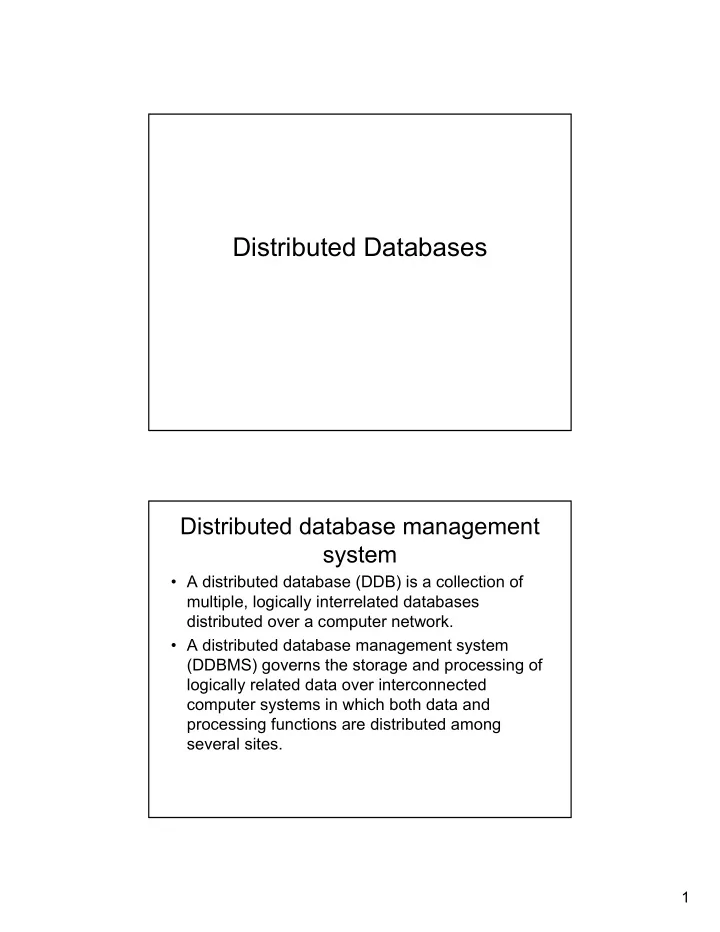

Distributed Databases Distributed database management system • A distributed database (DDB) is a collection of multiple, logically interrelated databases distributed over a computer network. • A distributed database management system (DDBMS) governs the storage and processing of logically related data over interconnected computer systems in which both data and processing functions are distributed among several sites. 1
Evolution • Centralized databases (1970’s) • Business operations became more decentralized geographically. • Customer demands and market needs favored a decentralized management style. • The decentralization of management structure based on the decentralization of business units made decentralized multiple-access and multiple-location databases a necessity. Advantages • DDBMS Advantages • DDBMS Disadvantages – Data are located near the – Complexity of management “greatest demand” site. and control – Faster data access – Security – Faster data processing – Design is more complex – Growth facilitation – Increased storage requirements – Less danger of a single- point failure – Cost compared to a client/server model 2
Distributed Process versus Distributed Database • Distributed processing shares the database’s processing among two or more physically independent sites that are connected through a network. • Distributed database stores a related database over two or more physically independent sites connected via a computer network. Distributed Processing DBMS Database Update Generate sales order Report 3
Distributed Database DBMS Database DBMS DBMS Database Database Components of a distributed database • Servers • Workstations • Networks HW/SW • Transaction Processor TP • Data Processor DP 4
The importance of transparency – Distribution transparency – Transaction transparency – Performance transparency – Heterogeneity transparency Distribution transparency • Three Levels of Distribution Transparency – Fragmentation transparency – Location transparency – Local mapping transparency • Supported by a common data dictionary 5
Transaction Transparency • Integrity is maintained – Remote Requests – Remote Transactions – Distributed Requests – Distributed Transactions • Two phase commit Two phase commit • DP transaction log • Protocol – DO-UNDO-COMMIT – Write ahead • Co-ordinator and subordinates 6
Two phased commit (cont) Phase 1: Preparation • The coordinator sends a PREPARE TO COMMIT message to all subordinates. • The subordinates receive the message, write the transaction log using the write- ahead protocol, and send an acknowledgement message to the coordinator. • The coordinator makes sure that all nodes are ready to commit, or it aborts the transaction. Two phased commit (cont 2) Phase 2: The Final Commit • The coordinator broadcasts a COMMIT message to all subordinates and waits for the replies. • Each subordinate receives the COMMIT message then updates the database, using the DO protocol. • The subordinates reply with a COMMITTED or NOT COMMITTED message to the coordinator 7
Performance transparency • Directly related to query optimization • Goal is to reduce costs associated with a request. – I/O cost – Communications cost – Processing cost Design of a distributed database • Partitioning • Replication • Location • Data fragmentation allows us to break a single object into two or more segments or fragments. • Each fragment can be stored at any site over a computer network. 8
Fragmentation • Fragmentation strategies – Horizontal fragmentation – Vertical fragmentation – Mixed fragmentation Replication of Data • Data replication refers to the storage of data copies at multiple sites served by a computer network. • Replicated data are subject to the mutual consistency rule, which requires that all copies of data fragments be identical. 9
Location • Data allocation describes the processing of deciding where to locate data. – Centralized – Partitioned – Replicated 10
Recommend
More recommend